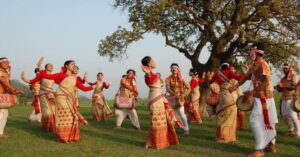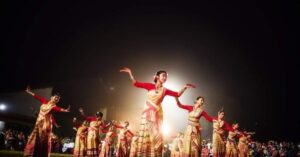The word “Bihu” can be quite perplexing for those unfamiliar with Assam and its culture. It encompasses various facets: it’s a dance, a festival, and it occurs three times a year, each instance bearing a distinct name and associated nickname. Terms like Bohag Bihu, Rongali Bihu, Kati Bihu, Kongali Bihu, Magh Bihu, and Bhogali Bihu often confound those outside Assam. However, for Assamese people, it’s all part of the same tradition.
Allow me to share a humorous anecdote about Bihu: During Bohag Bihu, I was with a Marathi friend who had spent a decade in Assam working for ONGC. He was somewhat acquainted with the Bihu Festival, and Bihu Dance, and even had a basic grasp of Assamese. When I invited him to my home in Assamese, saying “Bihu Khaboloi Ahiba,” he was puzzled. He remarked, “I’ve heard of Bihu dance and festival, but in my ten years here, I didn’t know ‘bihu’ could also refer to a dish we eat.” I was unsure how to respond. With his limited Assamese knowledge, he wasn’t wrong. “Bihu Khaboloi Ahiba” literally translates to “come to eat Bihu.” He reasoned that if Bihu could encompass dance and festival, why not a dish?
That’s the essence of Bihu. If you’re still perplexed, let me clarify: “Bihu Khaboloi Ahiba” means come to my house, we’ll celebrate Bihu and enjoy the special dishes prepared for the occasion. No, we don’t eat Bihu itself. On that day, I decided to write a blog about Bihu mainly to simplify it for non-Assamese people.
In this blog, we will discuss about Bohag Bihu, History, Rituals, its Celebration and the upcoming Bohag Bihu 2024.
Bihu Festival of Assam
Bihu festival of Assam is considered the most famous festival of Assam and is celebrated to honour the significance of agriculture in rural Assamese life. It is not a religious festival. The festival is celebrated by all Assamese people irrespective of caste, creed and religion.
The Assamese community observes three Bihu festivals, each corresponding to different stages of the year: Bohag Bihu in spring, Kati Bihu in autumn, and Magh Bihu in the post-harvest winter period. Bihu, rooted in agriculture and community traditions, aligns its festivities with seasonal changes and agricultural endeavours.
Of the trio of Bihu festivals, Bohag Bihu stands out as the most elaborate in terms of rituals, dance, song, and duration of festivities. That is why it is also known as Rongali Bihu.
Significance of Bohag Bihu in Assam
Bohag Bihu is a spring festival. It is a time when new leaves appear on trees, birds sing beautiful notes and romantic vibes fill the air of Assam.
As the famous singer Bhupen Hazarika said “ব’হাগ মাথোঁ এটি ঋতু নহয় নহয় ব’হাগ এটি মাহ অসমীয়া জাতিৰ ই আয়ুস ৰেখা গণ জীৱনৰ ই সাহ”. The line says Bohag is not a season for Assamese people nor just a month, it is the lifeline of the Assamese community. Such is the importance of Bohag Bihu in Assamese culture.
Traditionally, it marked the commencement of Kharif-paddy cultivation and served as a celebration of spring. In contemporary times, the festival typically commences on the 13th or 14th of April and is also acknowledged as the Assamese New Year festival.
The celebration of Bohag Bihu 2024 coincides with of the Hindu solar calendar (April 14, 2024). The day is celebrated in the states of Punjab as Baisakhi, Tamil Nadu as Puthandu, Vishu in Kerala, Pohela Baisakh in West Bengal and so on.
Origins and Traditional Roots
Numerous myths and legends surround the origins of Bihu, yet no definitive account exists regarding its inception. Among the tribal communities of Assam, it is referred to by various names such as Bihu, Bi-hau, Bisu, and Pisu.
Concerning the etymology of the term Bihu, some scholars attempt to link it astronomically to the vernal equinox, known as Sanskriti Vishuva Sankranti. From Vishuva, it becomes Bihu. This event occurs during the spring season, coinciding with the Assamese festivals of Bohag Bihu or Rongali Bihu.
It has also agricultural roots. The Bohag Bihu is celebrated in mid-April after the seeds of ‘Ahu’ paddy (dhaan in Assamese) are sown and before the seedlings of ‘Sali’ paddy are transplanted.
Rituals and Traditions of Bohag Bihu
There is a pre-Bohag Bihu celebration known as Chot Bihu or Rati Bihu. In ancient days, Raati Bihu celebrations start on the first night of the month of Chaitra (Chot in Assamese) and lasts till the commencement of Uruku (14 April). It was celebrated for a complete month or sometimes more than that. Nowadays, it is celebrated symbolically for a day or two. It is performed at night, so it is known as Rati (Rati means night in Assamese) Bihu.
The Main Bohag Bihu in Assam is a 7-day-long affair with elaborate rituals and traditions. Each day of these seven days is named as a separate Bihu. They are named as Goru Bihu, Manuh Bihu, Gohain Bihu, Kutum Bihu, Tator Bihu/ Nangolor Bihu, Jiyori or Senehi Bihu, Mela Bihu or Chera Bihu.
Goru Bihu: Goru Bihu, celebrated on the last day of the Assamese year, involves cattle worship. It is generally celebrated on April 14 (the next morning after Uruka). On the occasion of Goru Bihu, the cattle of the villages are brought to a single water source thoroughly washed and washed, smeared with turmeric, and blessed for health and productivity.

The tradition is that the cattle have to be struck with sprigs of dighloti and makhiyati (kinds of wild herbs) and the owners say to the castles: “Lao kha, bengena kha, bosore bosore barhi ja / maar xoru, baper xoru, toi hobi bor bor goru” (translation: to eat gourd, eat brinjal, grow from year to year / your mother is small, your father is small, but you be a large one).
Old ropes for the cattles are discarded, and new ones are tied. Cattle roam freely for the day. Afterwards, they are washed, fed various vegetables, and thanked for aiding in a good harvest. Special foods like Bor Pitha are offered in the evening.
Note: Isn’t it a amazing culture that the cows and cattle are worshipped during the first of Bihu?
Manuh Bihu: The second day of the Bohag month marks Manuh Bihu (‘Manuh’ symbolises “Elders” and Ancestral Spirits). People give offerings to the elders and the ancestral spirits and ask for blessings. People have a special bath with maah (black gram) and halodhi (turmeric), put on new clothes and light earthen lamps at Gohain Ghor (the household prayer place).
Gifts are exchanged during this occasion and almost every family offers the elders a Bihuwan or the Gamusa cloth as a symbol of respect. Nowadays, in addition to Bihuwan or Dhoti, modern clothes are also exchanged as gifts.
Gohain Bihu: It is observed on the third day of Bohag Bihu. During Gosain Bihu, individuals frequent Namghars and Kirtanghars, singing traditional songs like Bihu Naam, verses from Kirtan Ghosa, and Nam Ghosa to seek protection and blessings for a fruitful harvest.
Kutum Bihu: The fourth date of Bohag Mah is Kutum Bihu (“Kutum” symbolises “Kin”). On this day people visit their families, relatives and friends and have lunch or dinner together and share news and stories.
Tator Bihu/ Nangolor Bihu: Tatxaal (traditional Assamese handloom) and Nangol (plough) held significant importance in Assamese culture and society due to their utility. In the past, people revered these tools as a form of gratitude. However, these observances have become extinct in modern times.
Jiyori or Senehi Bihu: On the sixth day of Bihu, daughters return to their parents’ home for celebrations, known as Jiyori Bihu. Senehi Bihu is exclusively reserved for lovers, symbolizing love and reproduction. Youths meet their beloved and exchange gifts called “Bihuwan.”
Mela Bihu: The concluding day of Bihu features outdoor festivities and competitions, often in fairs known as Bihu Melas. In ancient times, kings and their retinues participated in such fairs to engage in Bihu celebrations. This tradition continues with modern Bihu Melas, attracting people from across Assam, fostering communal harmony, and promoting inclusivity.
Lastly, a Chera Bihu also known as Bohagi Bidai is observed. It is the wrapping up of Bohag Bihu festivities. It is marked by the exchange of Pithas made by different families during the Bihu week among their friends and relatives.
Evolution of Bohag Bihu Over Time
One of the most ancient manifestations of Bihu in Assam is Rati Bihu. This particular expression of Bihu predates any Bihu celebration in Assam. Rati Bihu was prevalent during a much earlier era, when the Mongoloids, including the Tai-Ahoms, began commemorating festivals centred around agriculture. It was during this period that Rati Bihu emerged. The ancient populace held the belief that indulging in sensuous dance and music in the fields enhanced fertility for crop cultivation, thus laying the foundation for Bihu in such a manner.
It was during the reign of Ahom King Rudra Singha (1665-1714 AD) that Rati Bihu transitioned from its rustic, rural origins, performed beneath trees, to the grandeur of the Rang-ghar courtyard, subsequently becoming a public spectacle.
Subsequently, Bihu transformed into a royal affair and expanded beyond its origins, spreading to other regions of Assam as the Ahom kingdom grew. With royal support, the attire, equipment, and art forms associated with Bohag Bihu, such as the Bihu dance improved.

However, in the modern era, Bohag Bihu has lost its traditional agricultural significance. It has become integrated into urban life, and the seven phases of Bohag Bihu are not celebrated with the same fervour as before. Goru Bihu is now primarily observed in rural areas, while Uruka (community feasts) has gained prominence. Manuh and Gohain Bihu continue to be celebrated in both cities and villages as holidays. However, the later days of Bihu have largely disappeared from people’s lives, existing only in books.
Traditional Bohag Bihu Attire and Adornments
Bohag Bihu attire is characterized by traditional garments and jewelry (Asomiya Gohona). Women typically wear a Mekhala as a lower body garment and a Chadar to cover the upper body. They adorn themselves with Assamese jewelry and flowers in their hair, coordinated with the color of their attire. Men usually wear dhoti-kurtas, often in combinations of red and white.
Common earrings for women include Lokaparo, Keru, Thuriya, and Jangphai. Necklaces such as Golpata, Joon biri, Bena, Gejera, Dhol biri, and Doog-doogi/Dugdugi are popular. Bracelets like Muthi Kharu and Gamkharu are also worn.
Husori: Community Gatherings during Bohag Bihu
During Rongali Bihu, or Bohag Bihu, youth engage in spirited singing and dancing known as Husori, accompanied by traditional instruments like the dhol, pepa, and taal. This tradition, prevalent in traditional Assamese villages, sees male performers forming groups and visiting houses to perform. They sing and play instruments while households offer respect by presenting xorai (a traditional offering tray) and gamosa (traditional cloth) to the performers. Elders lead the household in prayers for a prosperous year ahead. Notably, female members do not participate in this performance tradition.
Cultural Events During Bohag Bihu: Mukoli Bihu and Bihu Manch
Mukoli Bihu and Bihu Manch are among the most anticipated attractions. Mukoli Bihu, meaning open-field Bihu celebration, is organized in every locality and city, featuring Bihu dance performances, competitions, art exhibitions, and various cultural activities. The music festivals organized by Bihu committees are particularly popular and eagerly awaited by the Assamese people during the celebration
Check out this blog for Bohag Bihu wishes with pictures and quotes
Check out this video of Bihu Dance which set guiness book of world records for maximum participants





